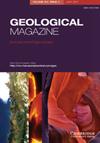中国南方寒武-奥陶系扬子碳酸盐岩地台古信风方向
IF 2
3区 地球科学
Q3 GEOSCIENCES, MULTIDISCIPLINARY
引用次数: 0
摘要
摘要四川盆地在寒武—奥陶系为扬子碳酸盐岩台地的一部分,海相碳酸盐岩沉积于此段。虽然前人对盆地的古地理、古气候和古生态进行了评价,但主要集中在盆地的古生态和生物演化方面;但对古地理和古气候的分析还比较缺乏。本研究综合了露头沉积学和磁组构资料,记录了YCP内的沉积分异和磁化率各向异性。本研究的目的是推断寒武—奥陶系各时期的古风方向,并限定YCP的古地理位置。YCP的西北部、中部和东南部分别以高能沉积(亚角-圆形)、中能沉积(亚角-亚圆形)和低能沉积(角-亚角)为主。早、中、晚寒武世的质心D-Kmax分别为北纬116°±52°、145°±57°和159°±62°;早奥陶世、中奥陶世和晚奥陶世的对应值分别为现今北纬169°±70°、139°±73°和91°±68°。沉积分异和AMS结果表明,早寒武世、中寒武世、晚寒武世、早奥陶世、中奥陶世和晚奥陶世的盛行风向分别为现今北偏296°±52°、325°±57°、339°±62°、349°±70°、319°±73°和271°±68°。本研究通过YCP上古风向与南北半球信风的对应关系,为YCP在寒武纪-奥陶纪的位置提供了证据。本研究的新颖之处在于:(1)将微相分析与AMS分析相结合,建立了古风型;(2)它限制了寒武纪-奥陶纪YCP的古半球位置;(3)为进一步研究寒武—奥陶系YCP的古气候和古地理提供了参考。本文章由计算机程序翻译,如有差异,请以英文原文为准。
Paleo-trade wind directions over the Yangtze Carbonate Platform during the Cambrian–Ordovician, Southern China
Abstract The Sichuan Basin was a part of the Yangtze Carbonate Platform (YCP) during the Cambrian–Ordovician, and marine carbonates were deposited in the basin during this interval. Although previous studies have evaluated the paleogeography, paleoclimate and paleoecology of this basin, they have primarily focused on the paleoecology and biological evolution in the basin; however, analysis of paleogeography and paleoclimate is lacking. This study integrated outcrop sedimentological and magnetic fabric data to document sedimentary differentiation and anisotropy of magnetic susceptibility (AMS) within the YCP. The aims of this study were to infer paleowind directions during each epoch of the Cambrian–Ordovician and to constrain the paleogeographic location of the YCP. The northwestern, central and southeastern sides of the YCP were characterized by high-energy deposition (e.g. sub-angular to rounded intraclasts), medium-energy deposition (e.g. sub-angular to sub-rounded intraclasts) and low-energy deposition (e.g. angular to sub-angular intraclasts), respectively. The centroid D-Kmax values for the Early, Middle and Late Cambrian were 116° ± 52°, 145° ± 57° and 159° ± 62° from the present north, respectively; corresponding values for the Early, Middle and Late Ordovician were 169° ± 70°, 139° ± 73° and 91° ± 68° from the present north, respectively. Sedimentary differentiation and AMS results indicated that the prevailing wind directions during the Early Cambrian, Middle Cambrian, Late Cambrian, Early Ordovician, Middle Ordovician and Late Ordovician were 296° ± 52°, 325° ± 57°, 339° ± 62°, 349° ± 70°, 319° ± 73° and 271° ± 68° from the present north, respectively. The present study provides evidence for the location of the YCP during the Cambrian–Ordovician via the correspondence between the paleowind directions over the YCP and the trade winds in the Northern and Southern hemispheres. The novelty of this study lies in the following aspects: (1) it integrates microfacies and AMS analyses to establish paleowind patterns; (2) it constrains the paleo-hemispheric location of the YCP during the Cambrian–Ordovician; and (3) it provides a reference for further studies of the paleoclimate and paleogeography of the YCP during the Cambrian–Ordovician.
求助全文
通过发布文献求助,成功后即可免费获取论文全文。
去求助
来源期刊

Geological Magazine
地学-地球科学综合
CiteScore
4.70
自引率
0.00%
发文量
111
审稿时长
3 months
期刊介绍:
Geological Magazine, established in 1864, is one of the oldest and best-known periodicals in earth sciences. It publishes original scientific papers covering the complete spectrum of geological topics, with high quality illustrations. Its worldwide circulation and high production values, combined with Rapid Communications and Book Review sections keep the journal at the forefront of the field.
This journal is included in the Cambridge Journals open access initiative, Cambridge Open Option.
 求助内容:
求助内容: 应助结果提醒方式:
应助结果提醒方式:


